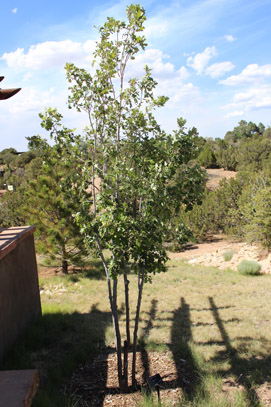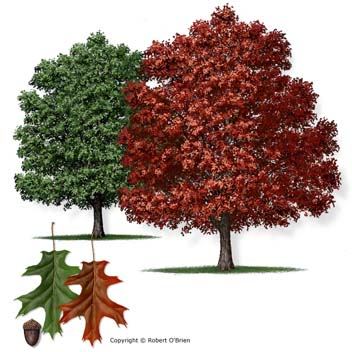Oak, Gambel - Quercus gambelii
 |
Food:
"In the fall the acorns were collected and ground into a protein-rich meal for mushes or cakes. --- Tannin-poor Gambel oak acorns, --- are actually somewhat sweet and can be eaten raw with no ill effects, as described to us by a man from Cochiti Pueblo who likes to chew on them whenever he's up in the mountains during deer season. At Santa Clara acorns may be cut into small pieces and used as a pie filler." (Dunmire and Tierney 115)
Recipe 1: Homemade Acorn Milk
"Blend 1/2 cup acorns and 1/2 cup raw almonds in a blender filled with water. Blend very well. Strain milk through a fine colander. Use as milk with granola cereal or muesli. Retain the mush and use for recipe below or for granola or cookies. Retain pulp for Dehydrator Acorn Crackers, homemade granola, or cookies.
Variation: Add honey or maple syrup to sweeten the acorn milk.
Note: If your acorns are high in tannin and bitter to the taste, leach first.
Recipe 2: Dehydrator Acorn Crackers
Cold-leach is desired, or use pulp from Homemade Acorn Milk. Use freshly leached acorn flour (not dried).
Start with 2 cups acorn mush. Add 1/4 cup chopped fresh chives, (My chives are usually giving me a second harvest about when the acorns are ready, so this is a good combination, but other herbs are great too.) Add salt, pepper, tamari, and hot chili to taste. Put herbs in blender or food processor, and blend well with acorn mush. Spread out onto a lightly oiled cookie sheet and bake at very low heat until crisp but not fully browned. Preferably, use a food dehydrator.
Variation: Substitute fresh or roasted poblano chiles for the chives." (Morgan 225-6)
Medicine:
"The basic astringent. A tea of the bark can be used with success as a wash for gum inflammations, as a gargle for sore throats as an intestinal tonic, and for diarrhea. For diarrhea, the most effective mode is a tablespoon of the bark boiled in a pint of water, the liquid cooled to body temperature and used as an enema. When drunk as tea, the tannin tends to bind with substances in the intestinal tract and only a small portion survives to act as an astringent in the colon. Although somewhat outmoded in clinical practice, tannin (from the bark or twigs) is still a useful treatment for first- and second-degree burns, acting as a binder with the proteins and amino aids of the weeping burned tissue and rendering them more impervious to bacterial action. All parts of the Oak are similarly useful as a first aid in inflammations, abrasions, and cuts, having a clotting, shrinking, and antiseptic effect. --- The leaves can be chewed into a bolus and applied to inset bites to reduce the swelling, and a piece of the bark can be chewed to lessen the pain from minor toothache." (Moore 116)
"Oak root bark was boiled to make medicinal teas for purging the system, for speeding delivery of afterbirth, for relieving pain after childbirth and for regulating bowel problems (especially in children). --- Oak wood was used to make handles for axes and hoes, digging sticks, weaving tools bows and arrows, baby cradles and ceremonial bullroarers." (Kershaw 47)
"(Isleta) Acorns eaten to give greater sexual potency. (Navajo, Ramah) Decoction of root bark used for postpartum pain. Decoction of root bark used as a cathartic. Leaves used as a ceremonial emetic. Decoction of root bark used for postpartum pain and to help in delivery of placenta. Root bark used as a 'life medicine.'" (Moerman 460)
Other Uses:
"Gambel oak boughs, tough and pliable, were used by different Pueblo people for making trays. Stouter wood was employed for digging sticks, clubs, and tool handles and sometimes for bows or arrow shafts. Two weaving sticks made of oak were recovered from a ruin dating to about A.D. 1500, located in Frijoles Canyon near the Bandelier Visitor Center. Remains of oak wood are almost always present among the excavated ruins of such prehistoric villages." (Dunmire and Tierney 116)
"(Navajo, Ramah) Whole trees used for shade house construction. Wood used to make frames for baby cradles. Red leaf galls and red clay or gum used to make stripes on arrow shafts between and below the feathers. --- Wood sticks notched by sheepherders to keep track of the days they have worked." (Moerman 461)
Oak, Chikapin - Quercus muehlenbergii
Oak, Texas Red - Quercus buckleyi

Oak, Bur - Quercus marocarpa
 |
 |
Leaf and bark |
Acorns |